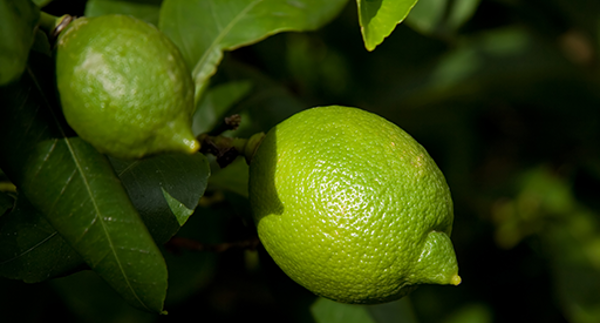
5 Steps to Lime Success
- Pick a lime variety based on your garden and cooking needs and choose a consistently sunny spot sheltered from cold winds.
- Prepare your soil with organic matter like compost and sheep pellets.
- Add a layer of citrus and fruit mix to plant into. In New Zealand plant limes during late autumn throughout spring in warm areas.
- Feed your limes in spring and summer to encourage maximum flowering and fruiting.
- Mulch and water well, particularly over the warmer months.
Follow our full guide below to a bumper crop of homegrown limes.
Limes are an essential ingredient in South-East Asian, Mexican, Latin American and Caribbean cooking.
Prepare
Limes prefer a warm situation and are sensitive to heavy frosts. Generally, all varieties grow best where they can be protected from winter frosts. They also need plenty of sunlight for adequate growth. Lime trees have a very deep root base and are good at searching the soil for water.
It’s best to buy a young lime tree from a reputable nursery, tree specialist or garden centre. Plant during late autumn throughout spring in warm areas. Where frosts are prevalent, don’t plant in winter.
Choosing a variety
Lime varieties are usually chosen for their distinct flavour. Below are some lime favourites.
- Bearss lime: medium-sized, seedless, tangy and very juicy fruit. Ideal for drinks and use in cooking.
- Makrut (citrus hystrix) lime: it is the leaves of this low-growing shrub that are most prized, especially as an essential flavouring in Thai cooking. The fruit has some juice, but isn't used as commonly as the leaves. Makrut limes aren't tolerant of really cold weather, but in good conditions can produce fruit year-round.
- Tahitian lime: vigorous, hardy trees that grow to 2-4 metres tall with drooping branches. Tolerant to the cold. Produces small, oval fruit that is bright green on the tree, becoming light yellow when ripe. The pulp is juicy and very acidic.
Plant
Like building a house a good foundation is the key to success in your garden. The better the soil, the better your plants will grow. If you are starting with an existing garden bed dig in organic matter like Tui Sheep Pellets and Tui Compost to your soil. Then you can add a layer of Tui Citrus & Fruit Mix. If planting in pots and containers, fill with Tui Citrus & Fruit Mix.
The best times to plant are early in the morning or late in the day, so the plants aren’t exposed to the hot sun straight away. Always water plants well before and after planting.
Planting in the garden:
- Soak your tree in a bucket of Tui Organic Seaweed Plant Tonic before planting and allow to drain. This will help prevent transplant shock and give your lime a healthy start.
- Add a layer of Tui Citrus & Fruit Mix to the planting area.
- Dig a hole, approximately twice the depth and width of the root ball of your plant.
- Gently take the plant from the current container, loosen the root ball and remove any loose or dead plant material and roots.
- Fill in with Tui Citrus & Fruit Mix. Press mix gently around the base of the plant.
- It is a good idea to stake when planting, as citrus don't like having their roots disturbed - this will help support the tree.
- Water your plant well and continue to water regularly.
Planting in pots and containers:
- Soak your tree in a bucket of Tui Organic Seaweed Plant Tonic before planting and allow to drain. This will help prevent transplant shock and give your lime a healthy start.
- Half fill your container with Tui Citrus & Fruit Mix.
- Gently take the plant from the current container, loosen the root ball and remove any loose or dead plant material and roots.
- Position the plant in the centre of the new container and fill with Tui Citrus & Fruit Mix up to 3cm from the top.
- Gently firm the mix around the base of the plant. The mix should be at the same level on the plant as it was in the previous container.
- Water your plant well and continue to water regularly.
In the first year after planting your lime tree, remove any fruit that sets. This allows the tree to establish itself and encourages better fruiting in the following seasons.
Nourish
Replenishing nutrients used by your lime tree ensures they will grow to their full potential, producing abundant and juicy crops. Feed your lime tree in spring and summer to encourage maximum fruiting and flowering. Citrus require higher levels of potassium and magnesium, and Tui Citrus Food is specially blended with all the nutrients needed for citrus planted in gardens.
For supercharged feeding with quick visible results try Tui Citrus & Fruit Liquid Superfood, perfect for pots and containers, as well as in the garden.
Magnesium deficiencies can be common in citrus, shown by yellowing leaves. Apply Tui Epsom Salts around the drip line of the lime tree (where the leaves extend to), to correct the deficiency.
Watering
Citrus require more watering over the summer months - and well watered, well nourished lime tree will have a better chance of keeping insect pests and diseases at bay.
The weather, weeds, pest insects and diseases can all impact on the success of your citrus. Protect your plants from the elements with layers of mulch, to help keep their roots moist. Keep the area around your citrus weed free.
Prune if you need to for either a desired shape, to remove any diseased stems, or to improve air circulation. Remember leaves are the life of the tree, so don’t cut unnecessarily, particularly before the tree has matured. If you are pruning avoid September/October as you run the risk of lemon tree borer laying eggs in the fresh cuts.